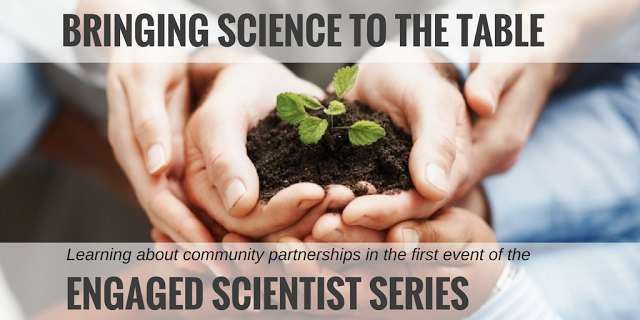TEX Director, Raj Pandya, participated in the first session of the University of Colorado Boulder Engaged Scientist Series. This program was designed to provide a source of knowledge and continued support for building relationships between scientific research and community engagement.
Following the event, Amanda Grennell (CU Boulder) shared what she learned on the blog, Science Buffs:
Bringing Science to the Table
What is an engaged scientist?
While many scientists recognize the need for better science communication and want to connect people in their communities with science, the nitty gritty of engaging with the public is not obvious. But, the nitty gritty is really where all the fun happens! At least that’s what I learned at the first Engaged Scientist Series seminar and workshop at CU Boulder.
Thanks to the Albert A. Bartlett Center for Science Communication, CIRES Education and Outreach, INSTAAR, and Learn More About Climate at the Office for Outreach and Engagement, graduate students at CU Boulder have the opportunity to learn what being an engaged scientist is all about.
To kick off the last event, Raj Pandya, program director for the American Geophysical Union’s Thriving Earth Exchange, began with a story most graduate students are familiar with. A young graduate student tries to explain his research to his grandmother year after year, finally coming to the conclusion that he just can’t do it – there isn’t even language for his research that his grandmother would understand!
But, Raj said, what if the graduate student thought of himself as a bridge between the community he’s from and graduate school? What if he not only thought of bringing his knowledge from graduate school to his community, but of bringing the resources, knowledge, and ideas from his community to graduate school, to inform his research? That’s the beginning of community engagement.
As with most things, there isn’t really a single definition of an “engaged scientists” – it’s more of a spectrum. As a scientist you can communicate TO a community (perhaps in the form of science demos or writing about science on social media), you can communicate FOR a community (the scientist testifying for Congress), or you can communicate WITH a community. That’s what community engagement really is – a conversation between scientists and the community, with input from both sides.
But, community engagement is based off of the needs of the community – not the scientist. Scientists must think deeply about how science can be used in the community, and be honest about what science cannot help with.
To do this, the scientist must assess the community as a whole – what is the history, geography, economy, and culture of the community? What kind of questions can scientists ask of community leaders to get answers to these questions? What expertise exists within the community? What are the strengths and weaknesses of the community? Only after these questions are answered can scientists design a project that pools the resources of the community and the resources of the scientists.
To understand how this difficult and somewhat vague process is actually done, we did a bit of role-playing and mock-interviewed the “city manager” (played by the Bartlett Center executive team) of a small town in Texas.
Here’s the setup: Scientists at UT Arlington had recently conducted water quality studies on the local river. The river did not meet federal regulations on levels of E. coli and heavy metals. The river was filthy with trash and a backyard salvage yard may have been contaminating it. The city wants to clean it up and install a riverwalk through town in an effort to increase tourism.
After interviewing the city manager, my group brainstormed science-based projects to propose to the city. The best idea we had was to pair a community river clean up event with river water collection both upstream and downstream of the salvage yard. We would then connect with the scientists at UT Arlington to test the samples. We would also devise a simple lab for testing of heavy metals in water – for example, the presence of high lead levels can be tested by adding a salt, making white flakes appear in the water. We would tailor the lab to be appropriate for all ages and implement it in local schools. Finally, we would ensure UT Arlington scientists followed up with community leaders on the results of the water quality study.
We also discussed challenges that graduate students might face in a community engagement project. They ranged from community members being skeptical of what scientists can do for them to the time commitment of the project to a PI who doesn’t see the value in doing a community engagement project. Since the project is all about helping the community, it may or may not result in publishable work. With our experience throughout the workshop and the input of many different perspectives, we were able to address all of these challenges.
Before this workshop, I had no idea that academic scientists can do these kinds of projects. The combination of using science to solve problems and the potential to make an immediate difference in people’s lives makes for exciting and useable science.
I am amazed by the potential to bring science alive in people’s lives by engaging and partnering with communities – ultimately working on science together.
By Amanda Grennell
This article was originally posted on sciencebuffs.org.

